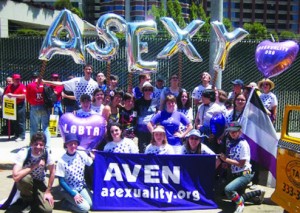Asexuals search for a place in gay culture
By Theresa Diffendal
The “A” in the acronym LGBTQIA+ that is used as an umbrella term for the queer community as a whole is thought by many to stand for allies. In fact, it represents a group with growing visibility: the asexual community.
Asexuality, defined as a lack of sexual attraction to other people, in conjunction with aromanticism, which a lack of romantic attraction to other people, exist on the aromantic/asexual, or aro/ace, spectrum.
The spectrum serves to show the degree to which people feel sexual or romantic attraction, with allosexual — those who experience sexual attraction on a regular basis, — at the opposite end of asexuality. Those who fall in between allo- and asexual on the spectrum often refer to themselves as “demi” or “gray” sexual or romantic.
However even as the queer community seeks to be all-inclusive and establish “safe spaces,” or places those with marginalized gender or sexual orientations can feel included, a rift has formed over the issue of hyper-sexuality.
Many queer-exclusive spaces have a reputation of being hyper-sexualized, such as Pride Parades, bathhouses, and gay bars. Many of these scenes also exclude members of the very community they are supposed to serve because they are only accessible to those over 21.
The increasing visibility of asexuality has many queer groups trying to find ways to adapt to accommodate those who do not engage in or are made uncomfortable by sexual activity.
The origination of the term asexuality as it refers to sexual orientation can be attributed to Michael Storms who, in 1979, put forth a model of sexuality similar to the aro/ace spectrum discussed above. The Kinsey Scale – a scale which rates sexual orientation from strictly heterosexual to strictly homosexual – also added the category “X” in its Kinsey Reports as early as 1948 to represent those who reported little to no sexual attraction.
Role of social media
Despite the early originations however, AVEN (the Asexual Visibility and Education Network) which focuses on issues related to asexuality, states that the first group for asexuals did not appear until October of 2000 in the form of a Yahoo group called “Haven for the Human Amoeba.”
Asexuality — and marginalized orientations in general — have often found acceptance and communities on the internet. Tumblr has a number of blogs whose purpose is to provide information about or help people come to terms with asexuality, such as asexual research.

